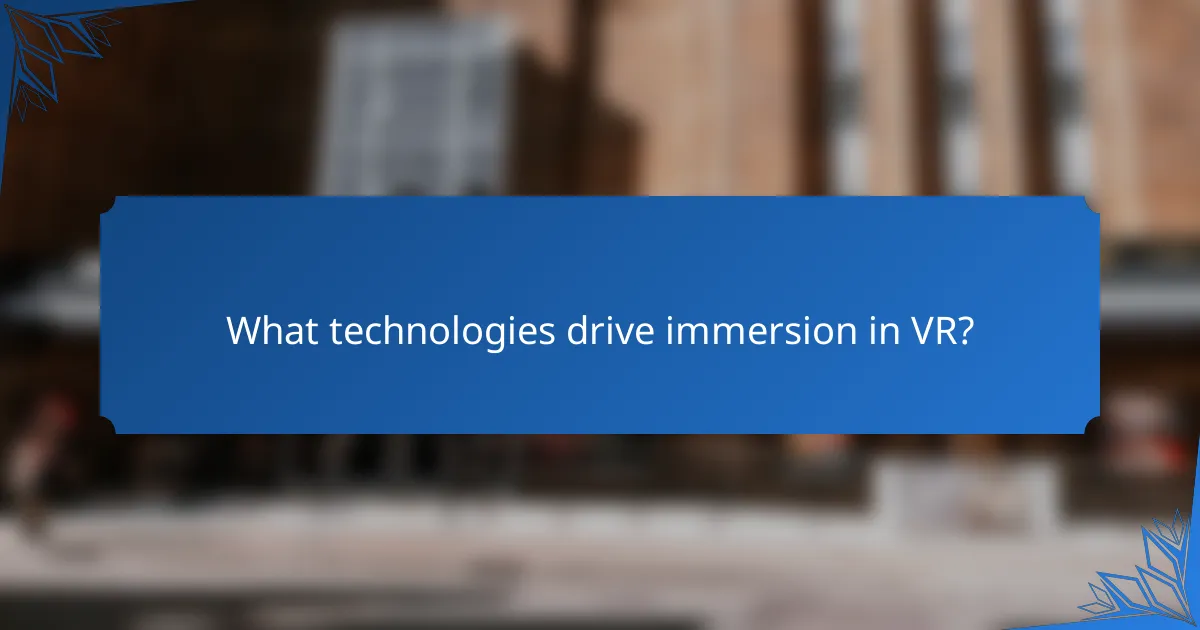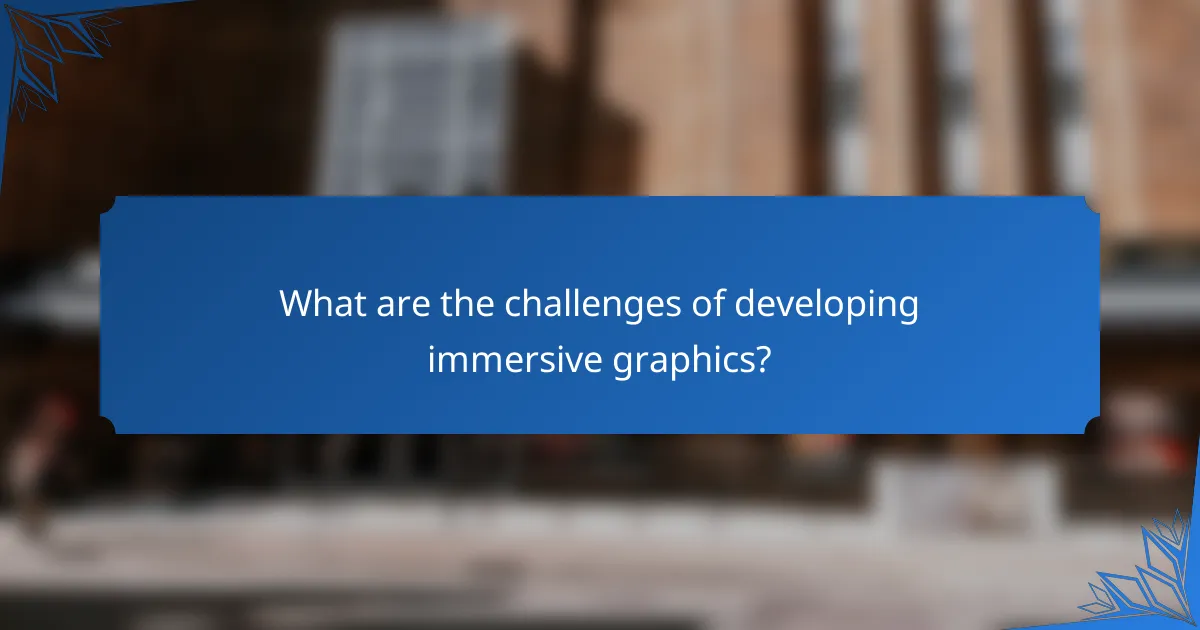Immersive graphics play a crucial role in enhancing player engagement by crafting visually stunning environments that fully envelop players in the game world. By stimulating the senses and fostering emotional connections, these graphics elevate the overall gameplay experience, making it more interactive and compelling.

How do immersive graphics enhance player engagement?
Immersive graphics significantly enhance player engagement by creating visually captivating experiences that draw players into the game world. These graphics not only stimulate the senses but also foster a deeper emotional connection and a more interactive gameplay experience.
Increased emotional connection
Immersive graphics foster an increased emotional connection by making characters and narratives more relatable. When players see lifelike expressions and detailed environments, they are more likely to empathize with the story and its characters.
This emotional investment can lead to longer play sessions and a stronger attachment to the game. For example, a well-rendered character’s facial expressions can evoke feelings of joy or sadness, enhancing the overall experience.
Enhanced gameplay experience
Enhanced gameplay experience is achieved through immersive graphics that provide intuitive feedback and visual cues. Players can better understand game mechanics when graphics clearly depict actions, such as health indicators or environmental hazards.
For instance, a dynamic visual representation of a player’s health status can prompt timely decisions, keeping players engaged and invested in the outcome. Additionally, smooth animations and realistic physics contribute to a seamless gameplay flow.
Realistic environments
Realistic environments are crucial for immersion, as they create a believable world that players can explore. High-quality textures, lighting effects, and sound design work together to simulate real-life settings, making the game more engaging.
For example, a virtual forest with detailed foliage and ambient sounds can transport players into a different reality, enhancing their sense of presence. Developers should focus on creating diverse and interactive environments to maintain player interest and encourage exploration.

What are the best VR platforms for immersive experiences?
The best VR platforms for immersive experiences include Oculus Quest 2, HTC Vive Pro 2, and PlayStation VR2. Each platform offers unique features, capabilities, and content libraries that cater to different user preferences and budgets.
Oculus Quest 2
The Oculus Quest 2 is a standalone VR headset that provides a wireless experience, making it highly accessible for users. With a resolution of 1832 x 1920 per eye, it delivers sharp visuals, and its library includes a wide range of games and experiences.
Consider the Quest 2 for its ease of use and affordability, typically priced around $299. It supports both gaming and social experiences, making it a versatile choice for casual users and enthusiasts alike.
HTC Vive Pro 2
The HTC Vive Pro 2 is designed for high-end users seeking top-tier performance. It features a resolution of 2448 x 2448 per eye and a wide field of view, which enhances immersion significantly. This platform is particularly suited for gaming and professional applications.
However, the Vive Pro 2 comes at a higher price point, often exceeding $800, and requires a powerful PC to operate effectively. Users should ensure their hardware meets the recommended specifications for optimal performance.
PlayStation VR2
The PlayStation VR2 is tailored for PlayStation 5 users, offering seamless integration with the console. It boasts a resolution of 2000 x 2040 per eye and advanced haptic feedback, enhancing the immersive experience in games.
Priced around $549, the PS VR2 is a great option for gamers already invested in the PlayStation ecosystem. It features exclusive titles that leverage its capabilities, making it a compelling choice for console gamers looking for immersive VR experiences.

How can developers create engaging VR content?
Developers can create engaging VR content by focusing on immersive experiences that captivate users and encourage interaction. Key strategies include utilizing interactive storytelling, incorporating user feedback, and implementing adaptive difficulty to enhance player engagement.
Utilizing interactive storytelling
Interactive storytelling allows players to influence the narrative through their choices, making them feel more invested in the experience. Developers should create branching storylines where decisions lead to different outcomes, enhancing replayability and emotional connection.
Consider using dialogue trees or environmental storytelling to immerse players in the world. For example, a player might choose to ally with a character, which could unlock unique quests or alter the game’s ending. This approach not only engages players but also encourages exploration and experimentation.
Incorporating user feedback
Gathering and integrating user feedback is essential for refining VR content and ensuring it meets player expectations. Developers should implement feedback mechanisms, such as surveys or in-game prompts, to understand player experiences and preferences.
Regularly updating content based on feedback can significantly enhance engagement. For instance, if players express difficulty with certain mechanics, developers can adjust the gameplay to improve accessibility. This responsiveness fosters a community feeling and encourages players to remain invested in the game.
Implementing adaptive difficulty
Adaptive difficulty adjusts the game’s challenge level based on player performance, keeping the experience engaging without causing frustration. Developers can design systems that monitor player actions and modify enemy strength, puzzle complexity, or resource availability accordingly.
For example, if a player struggles with combat, the game could reduce enemy health or provide additional resources. This approach helps maintain player motivation and satisfaction, as it ensures that challenges are always appropriate for their skill level.

What technologies drive immersion in VR?
Immersion in virtual reality (VR) is primarily driven by technologies that enhance the user’s sensory experience, making interactions feel more lifelike. Key technologies include real-time rendering, spatial audio, and haptic feedback systems, each contributing uniquely to the overall engagement and realism of VR experiences.
Real-time rendering
Real-time rendering is the process of generating images on-the-fly as a user interacts with a VR environment. This technology allows for dynamic changes in the scene, such as lighting adjustments and object movements, which are crucial for maintaining immersion. High frame rates, typically around 90 frames per second or higher, are essential to avoid motion sickness and ensure a smooth experience.
To achieve effective real-time rendering, developers often use graphics engines like Unity or Unreal Engine, which support advanced techniques such as level of detail (LOD) and occlusion culling. These techniques optimize performance by reducing the complexity of distant objects and only rendering what the user can see.
Spatial audio
Spatial audio enhances immersion by simulating how sound behaves in a three-dimensional space. This technology allows users to perceive sounds coming from specific directions and distances, making the VR environment feel more realistic. Techniques like binaural audio and ambisonics are commonly used to create a 3D soundscape that matches the visual elements.
When implementing spatial audio, it’s important to consider the listener’s position and orientation. Using audio engines that support spatialization, such as Wwise or FMOD, can help developers create an immersive auditory experience that complements the visual aspects of VR.
Haptic feedback systems
Haptic feedback systems provide tactile sensations that simulate touch and movement, enhancing the realism of interactions in VR. These systems can range from simple vibration motors in handheld controllers to advanced gloves that offer nuanced feedback based on user actions. Effective haptic feedback can significantly increase user engagement by making virtual interactions feel more tangible.
When designing haptic experiences, developers should consider the type and intensity of feedback to match the actions performed in the VR environment. For example, a light vibration may suffice for minor interactions, while more intense feedback may be needed for impactful events, such as explosions or collisions. Balancing feedback intensity is crucial to avoid overwhelming users while still providing a sense of presence.

What are the challenges of developing immersive graphics?
Developing immersive graphics presents several challenges, including hardware limitations and high development costs. These factors can significantly impact the quality and accessibility of virtual reality experiences.
Hardware limitations
Hardware limitations refer to the constraints imposed by the devices used to render immersive graphics. Many consumer-grade systems may struggle to support high-resolution displays and complex graphics processing, leading to performance issues like lag or reduced frame rates.
To create truly immersive experiences, developers often need to target high-end hardware, which can limit the audience. For example, VR headsets require powerful GPUs to achieve smooth visuals, and not all users have access to such technology.
High development costs
High development costs are a significant barrier in creating immersive graphics. The process often requires specialized skills, advanced software tools, and extensive testing, all of which can lead to substantial financial investment.
For instance, developing a single immersive VR game can range from tens of thousands to millions of USD, depending on the complexity and scope. This financial burden can deter smaller studios from entering the market, resulting in fewer innovative experiences for players.


